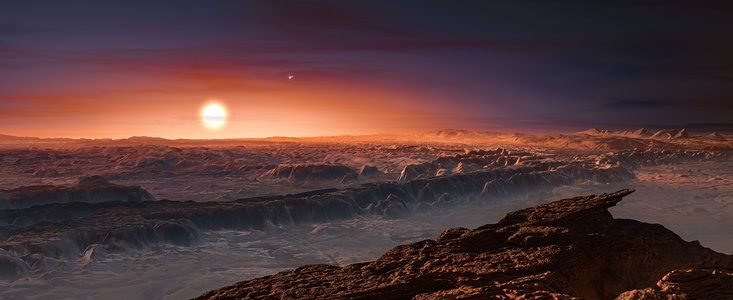Forget rocketing like Han, Chewy or Captain Kirk to the outer depths of the universe in search of friendly life forms. In a landmark discovery by the European Southern Observatory announced Wednesday, otherworldly extraterrestrial life could be chilling right around the cosmos from Earth.
An Earth-like exoplanet named Proxima b exists within the so-called “habitable zone,” orbits the closest star to our solar system, Proxima Centauri, and may support water and life!
According to the European Southern Observatory (ESO)—the foremost intergovernmental astronomy organization in Europe—astronomers using their telescopes have found “clear evidence of a planet orbiting the closest star to Earth.”
“The long-sought world, designated Proxima b, orbits its cool red parent star every 11 days and has a temperature suitable for liquid water to exist on its surface,” continues the historic announcement. “This rocky world is a little more massive than the Earth and is the closest exoplanet to us—and it may also be the closest possible abode for life outside the Solar System.”
Proxima Centauri, the space agency explains, is a red dwarf star just four light years away from our solar system, and the closest star to Earth apart from the sun. Although way too faint to be seen with the unaided eye, a team of astronomers monitored it much of this year using HARPS spectrograph on the ESO’s 3.6-metre telescope at its La Silla observation site—one of three such locations in Chile. Dubbed the “Pale Red Dot” campaign and led by astronomer Guillem Anglada-Escude from Queen Mary University of London, they focused their attention on the ever-so-slight “wobble” of the star that would indicate the gravitational pull of an orbiting planet.
“The first hints of a possible planet were spotted back in 2013, but the detection was not convincing,” explained Anglada-Escude. “Since then, we have worked hard to get further observations off the ground with help from ESO and others.
“The recent Pale Red Dot campaign has been about two years in the planning,” he continued.
When “Pale Red Dot” data was combined with observations from earlier ESO and other observations, the agency’s announcement explains, it yielded a phenomenal revelation: A planet was revolving around Proxima Centauri with a mass “at least 1.3 times that of the Earth, orbiting about 7 million kilometres…only 5 percent of the Earth-Sun distance,” ESO’s announcement continues.
Anglada-Escude was relentless in his pursuit of the Earth-like realm.
“I kept checking the consistency of the signal every single day during the 60 nights of the Pale Red Dot campaign,” he told media outlets. “The first 10 were promising, the first 20 were consistent with expectations, and at 30 days the result was pretty much definitive, so we started drafting the paper!”
Related: “Sonic Boom, Earthquake, Government Cover-Up, Meteor, Or Something More Sinister?“
Though Proxima b has a much closer orbit to Proxima Centauri than Mercury does to our Sun, its star is much fainter, ESO’s announcement says, therefore, this new world lies “well within the habitable zone around the star and has an estimated surface temperature that would allow the presence of liquid water.”
Main Photo: An artist’s rendition of the extraterrestrial landscape of Proxima b, an Earth-like world recently discovered by the European Southern Observatory, orbiting Proxima Centauri, the closest star to our solar system. (Art: European Southern Observatory)




























